|
...where Frisco Dwellers Fear to Tread... |
||
|
Page: |
Q! How heavy? A. Eighty three pounds soaking wet. And it is sealed against becoming soaking wet. Not enough to make it a submarine, however. After all, it rains out there. Not for use in swimming pools or puddles deeper than an inch or so. |
Click to Learn About: Updated 4 30 03 |
|
One of the most revealing comments I've heard by a new glider is this: "You know how few things that you experience strike you as being 'just right?' The cell phone was one. The CD. Anti-lock brakes. Seat belts. Jet travel. Light bulbs, sure. "But there's not a lot of them, and years could go by before technology hands you another one you can really appreciate. "The HT is one of them. Gee, what a cool thing." |
Q! What can a newcomer expect from the machine?
The body's reaction to the HT is interesting, and to a degree, predictable. The oscillation is referred to as "Newbie Shake" and similar colorful terms. A contest will be held to standardize such terminology or at least to expand its horizons. (Virgin Jitters?*) Step Up Stepping up is critical. Before you step, you need a visceral, hands-on feel for how the machine senses angle and turns that into motion. First, feel where neutral balance is by moving the handle bars to/fro. When the bars are forward of neutral, the machine rolls in that direction under power. Bars back of neutral make the machine back up. In between these two rolling relationships, a sweet spot exists that makes the machine stop moving. As you push/pull the bars, this mid spot can easily be felt. Only in the neutral mid spot should a novice step onto the base. And for newcomers, the sequence of stepping up is critical. 1. Arms forward, holding the handle bar grips at the neutral position, one lifts one foot onto the platform without putting weight on it.
3. The trailing foot now joins the first. At this point Trainee Stagger can occur. Most people encounter this on the first time they stand on the HT. Or, more rarely, the new rider finds their balance right away. Oddly, more women seem to get it right at first than men. It's like we guys don't trust the thing as much, or women have a naturally more adaptable sense of balance or some such. Double oddly, police trainees seem to be less willing to give up control to the machines and take a few extra seconds to stabilize. No other platform in your experience behaves like the HT. No doubt that the wealth of real-life experiences will lead to modifications and revisions of the internal HT operating system, but even in this first version the body/machine behavior match is amazingly good. If the operating system that is present in these first machines were compared to commercial software, the current refinement is somewhere in the Version 3.0 range, meaning that it is much more mature and trouble free than your laptop, for instance. Since the platform is driven by an intelligent process, mounting it might be likened to stepping onto the hand of a helpful giant who immediately decides he should treat you as an object to be balanced, much as you might actively balance a vertical yardstick in your palm. That's where the "Newbie Rumba" comes in. Of course, a yardstick has no ability to balance itself, so you and the giant might initially work at cross purposes until one or both of you agree how to produce the best result. Your brain can know this, but try telling anything to your feet. I tell first timers that they are about to experience a phenomenon. That when they step on a live HT for the first time, they will do the "Virgin Yo-yo", but that I'm going to show them how fast their own bodies can learn a new trick. No matter how much brain is applied, it's no match to how fast their own bodies will learn something. The initial shake will be a forward/backward oscillation covering perhaps +/- four inches. No big deal. A steady hand from the coach will supply the needed stability to the column, and that will dampen it out. Within seconds, the platform will be stable. This process is fairly typical, stemming from a newbie's tendency to pull the column toward them as they step up on the base or to their feet's inability to understand the balance thing.
Your brain very quickly adapts to HT balance, much faster than a new bicyclist can learn balance, and tons faster than a unicyclist can learn the unique balance feeling for that vehicle. In my checkered past, I taught myself the unicycle. It took days. Some people I've talked to got it quicker, but each had colorful stories. I decided, after the fact, that the sensation of unicycling was like walking inside a physically impossible greased hemisphere the diameter of the pedals. Once I got it, I rode on sidewalks filled with people, never thinking about collisions. I think the worst I did was brush shoulders, and never smashed into someone. Someday I'll tell you about the elevator full of Japanese businessmen I rolled into, but that's a different story. Back to the HT. Within the first minute of instruction, your body will learn that the platform of the HT can be trusted. It's behavior is completely consistent and reliable, and you can stand on it without thinking about its movements as instabilities. Everybody we've seen gets this within the first full minute. Standing is easy. As your weight shifts slightly, the HT will respond almost animal-like, keeping you vertical. Within another minute you and the machine will be thinking about other possibilities. Dean Kamen likes to tell people that you "think forward and you go forward," meaning that your body's natural tendency to step into an induced forward fall is how we walk. We've been balancing on two sticks all our lives, so how difficult could two wheels be? Fortunately, our brains adapt. So far two minutes have elapsed, and we have learned to balance on the most unusual looking device we have thought could ever balance. Just standing there is interesting, but it turns out that Dean is right. When your coach tells you to come toward him/her, the intellectual process of gear/clutch/gas pedal isn't available, but you glide slowly forward just the same. Your body language is the gas pedal. The same action your brain uses to lean into a first step forward is all that is needed. When you move a few feet closer to your coach, you slow and stop naturally, too, never realizing just how you did that. When you walk up to someone you don't think about how you stop walking--you just do it. The same bodily actions are at work here. When moving at speed, your backward lean--away from your direction of travel--stops you. For extreme cases, you can hunker down as you rear back on the reins--er handle bar--bending your legs and almost sitting. This tips the HT's base, informing its gyros to, "Hey! Stop already!," and it dutifully complies. On polished cement or tile surfaces you can squeak the tires doing this. It's good to know that you can stop faster than you can start. The braking is dynamic and not only stops you fast, but it pours some of your forward energy back into the batteries, giving them a moment of recharging. As you progress with going and stopping, the amount of lean to achieve a desired effect becomes completely somatic. Your body understands what your brain would have trouble analyzing. Connected to going forward is the notion
of going backward. It works the same and is as easy as stepping
backward. Clever that. But it is only the tip of the iceberg of well-thought-through notions built into the HTs. For instance, when you attempt to go faster than the machine is programmed to let you (depending on the start-up key color), the handle bar column pushes back and stands you more upright, thus slowing you down. You're fine as long as you don't try to force it, but it gives you a gentle tactile sense of the speed limit.
The left index finger/thumb will find the steering cuff. It's a rotating part of the grip that steers by wire. Twisting it clockwise steers right, counter clockwise steers left, and the distance it is turned relates to the amount of steer. The control cuff is egotistic; let go and it self-centers. Its influence on your motion becomes intuitive, but it takes practice to master. There go a few more minutes of learning. One thing to avoid: "pulse" steering--flicking it to change vector by a series of small moves. You can steer in place. Steering is really a matter of informing the wheels to turn at different speeds. The slightly faster wheel gets ahead of the slower one, and your angle of travel changes. If you are stopped when you turn the steering cuff, you spin in place. One wheel turns forward while the other turns at the same speed in reverse. Turning radius: zero. The tires are made to be non-marking. They shed dirt. They don't leave marks on wood, cement or carpet. And while you can see the dust on them that they pick up from an outdoor area, it comes off quickly. Areas around doorways to the outside don't appear to load up from HT dirt any more than they do from shoe traffic. As you move along on a straight stretch of sidewalk, you can effect a continuous, gradual turn by shifting your weight. Just press down on the left foot and you arc to the left. It might take you a hundred feet to actually run off the left edge of the walk, but you can feel the turn right away. Kewl! Steering is one thing, but cornering implies speed. The only oddity about the HT is that the wheels are in an unexpected place. As it turns out, the side to side arrangement is a two-edged sword. They cause the platform to be parallel to the ground side-to-side, which is counter to the experience we have with bicycles where the wheels are in a line making uneven ground tip us front to back. Bicycles naturally lean into turns, keeping our center of gravity over the frame of the bike. When we run in circles, we do this, too, leaning into the curve. The HT won't lean, so guess who's job that is. Everybody raise your hand. If you think of a virtual axle extending through the HT's wheels, that's the line that stays parallel to the surface you are on, but it means that as you move over uneven surfaces, the HT will rock side to side unlike anything in your experience except, perhaps, a canoe. That's not a good analogy; when's the last time you took a canoe over an uneven surface while its handle bars rocked side to side? The handle bar on the HT gives you ready stability, but in turns, you must provide the lean. Within ten more minutes of practice you will have learned all of this. Actually, your body will have learned it. You will be busy grinning. Even with everything seemingly under control, individual people's balance systems and incomplete understanding of the machine will allow them to quite naturally find trouble. As one stands behind the machine, one tends to pull the handle bars toward them. This tips the machine and causes it to back up into their feet. The confused rider then backs up, pulling the handle bars further back, the machine accelerates backwards, chasing them. Help! When being chased by a Segway, push it away at the handle bar level, and it will stop chasing you. Now try to remember that when it is chasing you! Things like this are why one needs a coach for the first half hour. Taller people can cause larger sways in a first time experience. They can operate the machine as well as anyone, but it seems that they, being longer pendulums, are initially less steady. The "step on / have a wiggle / step off / step on again --now more stable" instruction works wonders with vertically unchallenged folk. Some first-timers may not balance forward far enough. They may tend to step on the back portion of the foot plate instead of centering their feet over the middle of the foot zone. This leads to chronic backing up. The remedy is to put one's arches exactly at mid footprint on the base. Compounding this is that getting OFF a backing HT is difficult. People can try to stop too quickly. It's possible to exceed the control envelope of the HT if one presses for a stop too hard. The machine can dump you (as in "fall on your prat") if you attempt to lean too far backward in a braking maneuver. I know this one from first-bum experience. Gliding should be attempted conservatively, or on a carpet if you really must show off. Some people tend to stand on it too stiffly. Like they were at attention. Some leg flex is needed, especially in the turns, to let the machine twist and turn under you while you select your own balance points through the glide. This is also a thing you can practice intellectually, but which your body will learn, not your conscious mind. A lot of Segway HT behavior is non-mental. I can write about it until I'm blue in the finger tips, and you can read and re-read it until your eyes itch, but nothing in words will convey the sensations your body will use as its real instructional materials. Body: 6, Mind:0. Segway's instruction booklet is all about safety. They constantly remind you that you can get squished, bonked, pummeled, crushed, pinched, whacked and/or sliced if you don't do things right with your HT. They show you the right and wrong of it. Read it; it's good advice. Then you get the video. More safety. If you stopped after viewing the video, you might assume that, "Hey, no way, José. That thing's just too dangerous," but think about it from the view of the company. They're just trying to install a sense of caution in your eager brain. If you deviate from these instructions, you do so strictly at your own risk, and the risk to an owner is not just for their own health and lack of band-aids, but for the unhealthy smacking, dropping, denting, cracking and/or breaking their $4.5 G machine. Be Aware. It's not a toy, just a thing that you have a lot of fun with. Of course, Segway MUST take this sort of position. If they were to advise you to get reckless with their machine, they would be sued out of existence. There are no-nos to be observed as per Segway LLC and personal experience:
If operated wrongly, you can tumble, fall off, slide on unstable surfaces and try to push the machine beyond its limits. Any of these can hurt you. In opposition to street traffic, cars, trucks and bicyclists, most of them will win ANY confrontation. If a fault were to occur, the machine will go into emergency stop mode and do whatever it considers appropriate to get you stopped safely. Within ten seconds the HT will clatter and beep to a stop and go stupid. You can roll it around manually after that, but don't think of it as a ride machine any more. Maybe you just ran out of juice? Maybe it was equipment failure? Maybe you now need a taxi. In Power Assist mode (easy to switch to) you can push the HT ahead of you like an old time lawn mower. Doing so will cause the machine to resist the move, but that's not a bad thing. When you feel resistance, it's not because the gears are gummed up, it's because the motion is being pushed through magnets into the motors, and that work is being turned into electricity which is doing a low-grade charge of the batteries. Aha! Jogging with your HT may actually ADD power back into dead batteries! Jog with it for a few blocks, and you might get to glide for a few blocks more! After you get used to it, you will find that the start-up and go sequence is very easy to get used to. It becomes a fluid move after a while. And with something this naturally fluid, it begs to be mastered. As my daddy always said, you can't learn to dance by just standing around. Reactions As you zip around neighborhoods and into the city center, you will get reactions. It's inevitable. One guy stopped his Mercedes in the middle of the street and shouted, "I want to SEE that!," then parked and trotted across the street. Now he wants to buy one. The most frequent quick reaction is, "COOL!" followed by "I gotta get one of those!" or similar phrases. Then they get into the standard questions (below). The one thing that people do NOT get into right away is this: "&%$#@!! sidewalk hog!" --or anything like it. In all my glides, it has never happened once to me. Just about 99.987% of the people who see it for the first time brighten up and start smiling. It gives me a ready reason to smile back. (As if I needed motivation for that.) Glidewalks The sidewalk now becomes a GlideWalk. It is the appropriate place to glide and interacting with people there is intuitive, easy, safe and pleasant. People give you their maximum grin most of the time, and you will get a lot of questions. Some people will exhibit the horseless carriage effect: They will react the way early horses did at the sight of the first cars by getting the heck out of the way. Relax. It's just unfamiliarity. The next time they see one, they will be more casual. When people do this, I generally comment with something like, "Thanks, but you didn't have to do that..." Then there are the five standard Questions. It is important to realize that when people ask questions, they really don't want to hear "Five thousand dollars," "Here's the URL on the Internet," or "No faster than 12.5 miles per hour." What they want is the story about the machine. Their questions are a means to get inside "the know" by talking to someone at the horse's mouth, so to speak. It's a subtle difference, but by giving a bit of context with the answer, you engage them in the lore of the Segway at a personal, authentic and memorable level. If you show them *anything* that they couldn't get from a TV news story, you will have made their day! Rock it back and forth. Spin it around in a quick 360. Take your hands off the handle bars for a moment. And especially, give them an interesting answer: How much does that thing cost?
Where can I get one?
How fast does it go?
How far can it go?
I hear they're banned in San Francisco!
When does the machine's abilities allow you to achieve more than just standing on it? Can you dance on the HT? Where are the limits? And can you safely push them? With a bit of extra awareness, you can widen the envelope of behavior on the HT and do things from the mildly interesting to the truly dangerous. No doubt the HT will become a prop for acrobats. Cirque du Rollay. Here is a list of moves the machine is capable of accomplishing. None of these are Segway-approved nor particularly approved by me. They just describe what you may see when experts get ahold of the HT. You risk a lot if you try them. As my mother always said, "If you fall down and break your leg, don't come running to me." She also said, "Don't bleed on the rug." Capisce?* Tofro. With rhythmic aplomb, one may rock the HT forward and backward over and over. It looks like one of those square dance moves where you step in, then back, then in, then back again. It's a rather controlled version of the Tyro Gyro and it looks interesting to observers. Zags. Pirouette. Extension. Up. When it decides to shut you down, there is no argument. It vibrates, honks, slows automatically and calls attention to itself in every way it can. Bystanders will quickly realize that you've pulled a stupid move and they will laugh at you behind their hands. Or point and jeer. It depends on your audience.
Bush If you can make this thing balance for five full seconds without power (on your first try), I'll give it to you. If you fail, you have to buy me one. Siddown. Now that your sense of show-off has been heightened, every curb, ramp, sidewalk crack, pebble and bump becomes more dangerous. This move tells us that a wheelchair based on only this technology is possible, and perhaps in the works. The DEKA iBot can do a lot more, but it can't cost merely five grand. One Segway owner without legs has already adapted his as a motorized runabout. He built a box seat that sits right on the platform and he uses the body language of his torso to accelerate and brake, same as everyone else. Hello,
Dolly. Time's up If you did all this on the back of a Segway HT, you are no longer a newcomer. If it has taken you more than 15 minutes to learn, it's only because you were deliberately taking your time and practicing things as you progressed. Practice will now become your best teacher. Before you take it out into the real world, make sure you have hours of practice under your belt. Slaloming, spinning in place, intuitively dodging things, learning the safety of dismounting quickly--all these await your intermediate and expert levels. Buying one ...couldn't be easier. Click this link and you will see the Amazon Order page. If you order through this site, we will gladly give you a demonstration ride in our offices in Burbank California. Not too handy if you are in Fargo, but easy enough if you live in the LA area. Amazon will charge you only $495 to start the process. Segway will contact you in a few days and give you your options. Clicking here is the fastest way to start the process. When they ship the HT, you will be charged $4,000 plus taxes and delivery fees. It comes in a huge box that looks like it might house a big TV and assembly is a breeze. All you have to do is connect the handle bar to the base and plug a couple of connectors together. Before you receive the unit, Segway will train you with a video tape, a detailed guide booklet and personal instruction at a hotel or conference center near you. Onward and outward Once you get the HT, a good rule of thumb is this: Practice with the HT for at least an hour of gliding on a rug surface or a wood surface that has some give to it. Traction on a rug is excellent, but don't try to stop on throw rugs that are on a slick floor. You can ride and practice on a lawn (it won't tear up the grass) and that's a good option. If you fall on these sorts of surfaces, you won't break anything. After the first hour, tentatively move to the sidewalk in a place that has low to zero foot traffic. Pay EXTRA attention to driveways, alleyways, curbs, intersecting walks and any place where a person, bike, car or traffic could surprise you. See page 3 of this site. Too many vehicles don't stop at sidewalks. Too many people turning corners don't look for pedestrians. People think that sidewalk in front of their house is not the place to stop before entering the street; the street is. Your $4,500.00 device is in danger. Be prepared to shout a stern, "HEY!" at the top of your lungs. That has already saved me from being run over by a Corvette owner who didn't think to look to the right as he started to pull out onto the street. One interesting side effect that may occur to you too, is this: You will become MUCH more pedestrian-aware as you drive your car after gliding around for a while!! Glide safe. |
EXPERIENCED GLIDER: When viewed from afar, the HT is very easy to misjudge. Some folks see it as a magic carpet; others see it as a terrible threat to the safety of pedestrians and small dogs. Neither is the case. The Segway HT is very good at exceeding most people's expectations, but a small population of folks may not warm up to it. The ratio of those who "get it" to those who don't like it is about 2000:1, it would appear. Nearly everybody I've experienced from gliding through Beautiful Downtown Burbank has received its unexpected appearance with enthusiasm, smiles, questions, nudges, greetings, laughter, cries of "I've got to get one of those," and warmth. Not a single person, so far, has complained of its presence in any way, shape or form. There are people who imagined that the presence of an HT within a group of pedestrians would constitute a danger. So far, nothing of that sort has been in my experience, which grows daily. I often stop to chat with people about it, informally, as I glide around Burbank, and people are amazed to see it balance, stopped, barely moving. Most of the media footage they have seen shows it moving, not simply balancing, and when they see it purposefully and effortlessly NOT moving, it changes their perception of it. The experience of using the HT in a fairly dense urban sidewalk area (the people count per square meter here is close to what I've seen in many much larger cities) is teaching me things about co-existing with pedestrians, and has also given me an extra level of pedestrian awareness when I drive my car, too. I didn't expect that. But after seeing how casually automobile drivers treat sidewalk crossings, I've noticed that my scrutiny of driveway exits, outlets to streets and even intersections has ratcheted up a full notch when I drive. When among dense foot traffic, the only right way to behave is this: Unexpectedly. In other words, don't do the unexpected. If people are sauntering, glide at a sauntering pace. If they're moseying, you mosey, too. I've become extra adept at sashaying, ambling, rambling, meandering, dawdling, wandering and traipsing recently. Since people have no eyes in the back of their heads, they can't hear the HT coming up behind them when the crowd is noisy. On quiet sidewalks, the HT emits a distinctive whine or chord-like hum. It's certainly not the stealthy audibly invisible object some critics have labeled it. Blind folks tell me that they heard me coming from more than a dozen feet away. Since pedestrians are unpredictable, one can't follow them too closely. A polite, "Excuse me," does wonders when they simply stop, blocking the way, just as it would if you were simply walking along. When the way is clear, you can make up time spent negotiating foot traffic, so there is no rush. If one is in a rush, there is always the option of gliding where bicycles are permitted. But if that means The Street, extra caution is called for. Cars kill pedestrians every day. And all the HT gives you is an amplification of the pedestrian role of locomotion, not extra protection from a Pontiac. Like anything you would use on a sidewalk, the advantage it gives you must be balanced with responsibility. Folks walk on sidewalks, and some of them don't get around very well. Toddlers and very little kids must be watched out for, just the way one would maintain extra awareness of them when on foot. Their level of personal responsibility is low, so when gliding with an HT in an area of small children, the rider MUST be aware. Fortunately, kids don't grab at the HT any more than they do to a bicycle, which is full of many more sharp edges, finger catchers, metal points, spokes, struts and dangerous hand traps. Still, if you find yourself in a situation where toddlers or small children are mobbing you, get off the HT and flick it into Power Assist mode until you can be sure none of them are in proximity to you and the machine. Many older citizens have grown beyond easy walking and use canes or walkers to get around. These folks deserve extra consideration and accommodation, too. Responsibility is more than duty, it actually means "the ability to offer a response" in a meaningful way. Interestingly, the HT is doing its utmost to provide exactly that, the ability to respond. It's far easier to stop than skates, and much more intuitive than a bicycle, and Segway is providing all the Amazon.Com purchasers with a personal training class to bring the sense of safety and responsibility into clear focus. It's fairly easy to get zoomy on an HT, and at the class I attended, a rock star (literally) was the class hot-shot who proved the rule, "What can you tell a thirty-something millionaire?" "Nothing." But I digress. Most people will get more out of the Segway by being able to gracefully show it as an improvement in transportation rather than as a demonstration of ego. We who are the first adopters will be the ones who establish its role in society. Wisdom comes slowly, but surely. And inside the HT, the designers have put as much wisdom as is technically possible. As you tool around on it for the first hour, give yourself small challenges.
All of these are about to become useful skills. |
| *Information presented here is for your wonder and amazement only. No suggestion of what you should do counter to Segway LLC's own excellent manuals and videos is implied. I'm just talking, here. Don't ever do anything dangerous with your HT. Capisce is Italian for "Get it?" Get it? | ||
|
|
||
|
||
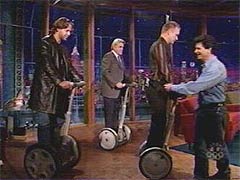 Segway HT™ instruction and deduction.
Segway HT™ instruction and deduction.
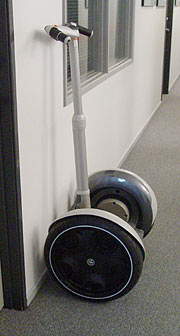 A. The
first time you step on an HT, somebody will most likely be coaching
you. Your feet will probably have
opinions about the surface you've stepped on, that your conscious
mind won't have formed. The coach should be there to control
the natural tendency in most folks to oscillate to/fro a bit.
A. The
first time you step on an HT, somebody will most likely be coaching
you. Your feet will probably have
opinions about the surface you've stepped on, that your conscious
mind won't have formed. The coach should be there to control
the natural tendency in most folks to oscillate to/fro a bit.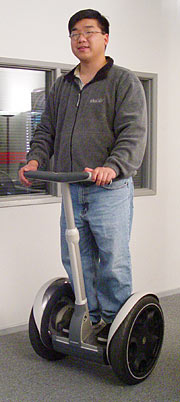 2. Concentrating
on balance, one now shifts one's body weight to the HT foot pushing
straight up. It's like carefully stepping onto a curb
of ice. Not that it is slippery, but that it deserves your concentration
to avoid unexpected moves.
2. Concentrating
on balance, one now shifts one's body weight to the HT foot pushing
straight up. It's like carefully stepping onto a curb
of ice. Not that it is slippery, but that it deserves your concentration
to avoid unexpected moves.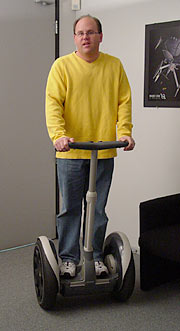 Then, immediately, I have them step off and back
on again. Surprise! The second time they step up onto the HT,
the entire "Newcomer Bummer" will have disappeared
or dropped to 1/3 or less intensity. It's like their feet have
learned what the mind thinks it knew all along.
Then, immediately, I have them step off and back
on again. Surprise! The second time they step up onto the HT,
the entire "Newcomer Bummer" will have disappeared
or dropped to 1/3 or less intensity. It's like their feet have
learned what the mind thinks it knew all along.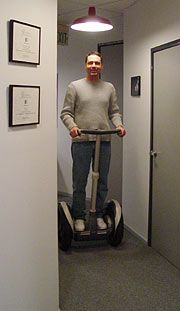 Next, you will learn to steer with the hand grips
on the handle bars. When you see these in pictures, they may
look to be at an odd angle to you, certainly they follow a line
in space different from many scooter and bicycle grips. But once
balanced, they feel intuitively right to your hand, having been
designed to the angle your grip naturally assumes.
Next, you will learn to steer with the hand grips
on the handle bars. When you see these in pictures, they may
look to be at an odd angle to you, certainly they follow a line
in space different from many scooter and bicycle grips. But once
balanced, they feel intuitively right to your hand, having been
designed to the angle your grip naturally assumes.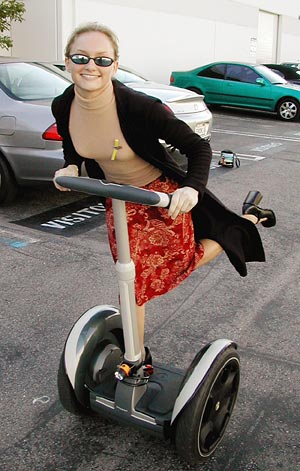 Pushed Limits
Pushed Limits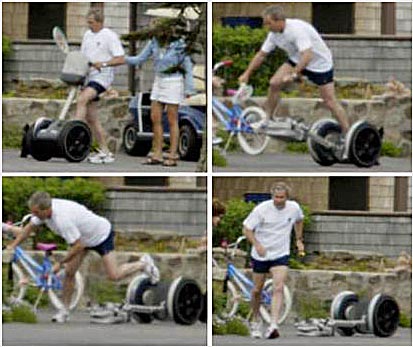 Lookma.
Lookma.